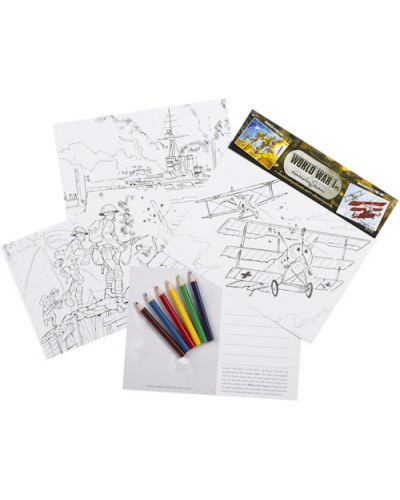Product Description: The World War I Colouring Postcards consists of four A5 size colouring cards and six colouring pencils. The cards include an image of British soldiers ‘going over the top’, an aeroplane dog fight, a tank on the battlefield and a ship under fire. On the reverse of each card is an area to write a message, an address and to affix a stamp as well as educational information about the images on each card. There is a colourful header card that has pictures showing how the cards could be coloured in and all are held in a clear cellophane bag.
Information: Much of the fighting during the First World War was done from trenches. The floors of these trenches were made from wooden planks called duckboards and the sides were supported by sandbags. Whole systems of trenches, backup trenches (in case the first lines were overrun) and communication trenches were developed, often stretching dozens of kilometres along a front without interruption. Both allied and enemy troops were sent ‘over the top’ of these trenches to attack each other, often with disastrous consequences.
The term ‘dogfight’ originated during World War I and referred to aerial combat between fighter aircraft. Aircraft were initially used as mobile observation vehicles. These aircraft soon became targets from other planes who originally threw bricks, grenades and fired pistols at them. Once machine guns were mounted to these and other planes, either on a flexible mounting or higher on the wings of early biplanes, the era of air combat began.
During World War I (1914-1918) the British invented and implemented the first working ‘tank’. The name tank originated when the British shipped them in crates marked ‘tanks’ trying to cover up what they really were. The tank was first employed in significant numbers at the Battle of the Somme. Though the tank was highly unreliable, it did a great deal to end the horrors of trench warfare and brought back some mobility to the Western Front.
The Battle of Jutland was the largest naval battle of World War I between the Royal Navy and the German Navy and the only full-scale clash of battleships in that war. It was fought on 31 May – 1 June 1916, in the North Sea near Jutland and at the end of the battle both sides claimed victory. The Germans continued to pose a threat but they never again contested control of the high seas. Instead, the German Navy turned its efforts and resources to unrestricted submarine warfare.
Tags: World War I, Educational, Colouring, Postcards

